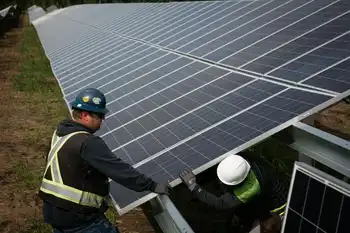New York State has mixed success with renewable program
By Associated Press
Protective Relay Training - Basic
Our customized live online or in‑person group training can be delivered to your staff at your location.

- Live Online
- 12 hours Instructor-led
- Group Training Available
New York energy officials say they believe state agencies are now consuming 10 percent or more of their electricity from renewable sources — a target that was supposed to be met in 2005 under an executive order. But they are optimistic the state can meet the next target of 20 percent renewable consumption by 2010, despite the slow progress by the state university system and some other agencies.
"We're halfway there and the ramp-up has been substantial," said Tom Lynch, a spokesman for the New York Energy Research and Development Authority. "All the tools are in place for the agencies to meet this."
The concerted push for renewable power in state buildings dates to June 2001, when then-Gov. George Pataki signed a sweeping executive order setting a series of clean energy goals for state agencies. The renewable energy targets are among a series of goals that include decreasing overall electricity use and buying clean-fuel vehicles.
Agencies can arrange to buy or generate their own green power, but will commonly enter into group contracts managed by the state Office of General Services for "renewable energy credits" that represent clean energy pumped into the electrical grid. Agencies are only responsible for leased space if they pay the electricity bill. Mandated reductions in overall electricity use can also get agencies there faster.
The OGS, with 53 buildings statewide, has cut down its total energy consumption by 12.5 percent.
"We've been pretty strident about our energy conservation measures," said Brad Maione, a spokesman for the department.
The renewable program started by Republican Pataki has continued under Democratic Gov. David Paterson, who wants homes and businesses across the state to rely more on renewable energy. Paterson wants New York to meet 45 percent of its electricity needs through improved energy efficiency and renewable energy by 2015.
Only some agencies met the 10 percent-by-2005 goal. As of March 2007, the most recent date for which statewide data available, 9.3 percent of state agency electric consumption was from renewable resources. It's not clear precisely how far the state has progressed since then, since the reports submitted by state agencies to NYSERDA in December are still being reviewed.
But Lynch said the market for renewable energy has boomed in recent years and "if that trend continues, we will meet the 20 percent" goal. The recently approved federal stimulus package is expected to boost the renewable market even more. Though the order sets the target at 2010, agencies actually have until the end of the fiscal year that starts in 2010 and ends March 31, 2011.
The executive order includes no penalty for agencies that fail to make targets.
"These goals are not easy, it's hard to get there," Lynch said.
At least 10 state agencies out of about three dozen already meet or exceed the 20-percent goal, according to the 2007-2008 information the agencies reported to NYSERDA in December or answered in queries from The Associated Press. That includes large agencies like the Dormitory Authority and the state Department of Environmental Conservation.
But a few agencies report still being short of the 2005 target, including the Division of Military and Naval Affairs, the state Insurance Fund and the State University of New York, one of the largest electricity customers in the state.
SUNY spokesman David Henahan blamed budget cuts in the current fiscal year combined with the high cost of renewable energy and renewable energy credits.
Renewable energy still costs a little more. Prices vary based on how it's generated, though NYSERDA officials say agencies hitting the 20 percent threshold could pay up to 2 percent more on their total bill. For instance, the Office of Alcoholism and Substance Abuse Services, at 63 percent renewable, pays about $8,000 more on its annual electric bill of $330,000.
Agency spokeswoman Dianne Henk said it's worth the investment given energy conservation and global warming concerns.
"We have to be responsible," Henk said, "and this is part of this responsibility."











